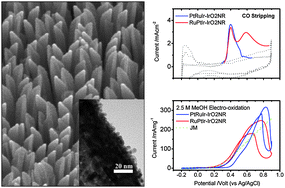Pt–Ru and Pt–Mo electrodeposited onto Ir–IrO2nanorods and their catalytic activities in methanol and ethanoloxidation
Abstract
Pt–Ru and Pt–Mo electrocatalysts are prepared via pulse

* Corresponding authors
a
Department of Chemical Engineering, National Taiwan University of Science and Technology, 43, Keelung Road, Section 4, Taipei, Taiwan
E-mail:
dstsai@mail.ntust.edu.tw
b
Department of Electronic Engineering, National Taiwan University of Science and Technology, Taipei, Taiwan
Fax: +886-2-27376644
Tel: +886-2-27376618
c Department of Chemical Engineering, National United University, Miaoli, Taiwan
Pt–Ru and Pt–Mo electrocatalysts are prepared via pulse

 Please wait while we load your content...
Something went wrong. Try again?
Please wait while we load your content...
Something went wrong. Try again?
X. Jian, D. Tsai, W. Chung, Y. Huang and F. Liu, J. Mater. Chem., 2009, 19, 1601 DOI: 10.1039/B816255G
To request permission to reproduce material from this article, please go to the Copyright Clearance Center request page.
If you are an author contributing to an RSC publication, you do not need to request permission provided correct acknowledgement is given.
If you are the author of this article, you do not need to request permission to reproduce figures and diagrams provided correct acknowledgement is given. If you want to reproduce the whole article in a third-party publication (excluding your thesis/dissertation for which permission is not required) please go to the Copyright Clearance Center request page.
Read more about how to correctly acknowledge RSC content.
 Fetching data from CrossRef.
Fetching data from CrossRef.
This may take some time to load.
Loading related content
